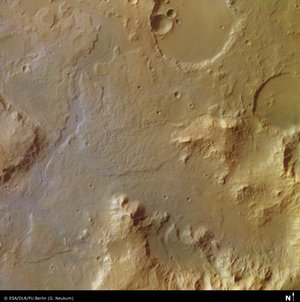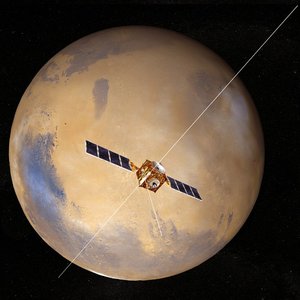Tributes to wetter times on Mars
A dried-out river valley with numerous tributaries is seen in this recent view of the Red Planet captured by ESA’s Mars Express.

This section of the Libya Montes region, which sits on the equator at the boundary of the southern highlands and northern lowlands, was imaged on 21 February 2017 by the spacecraft’s high-resolution stereo camera.
The Libya Montes highlands mountains, one of the oldest regions on Mars, were uplifted during the formation of the 1200 km-wide Isidis impact basin some 3.9 billion years ago, seen at the north of the context map.
The features seen across the broader region indicate both flowing rivers and standing bodies of water such as lakes or even seas that were present in the early history of Mars.
The prominent river channel that runs from south to north (left to right in the main colour image) is thought to have cut through the region around 3.6 billion years ago. It apparently originates from the impact crater in the south, breaching its crater wall and flowing towards the north, navigating the hummocky mountains of the local topography.

The valley is fed by numerous tributaries, pointing to extensive rainfall and surface runoff from higher to lower regions. Groundwater seepage is also thought to have played a contribution in shaping the valley. A similar channel snakes its way across the bottom right of the scene.

The mineralogy in the Libya Montes region is very diverse, as revealed by orbiting spacecraft. Aqueously formed and chemically altered minerals testify to past hydrothermal activity that may be linked to the formation of the Isidis impact basin. For example, the impact could have mobilised liquid water by melting subsurface ice that subsequently interacted with the ancient, volcanic mountain rocks.

Numerous craters in various states of degradation pockmark the entire scene, testament to the region’s long history. Perhaps the most noticeable craters are the two situated side by side close to the centre of the scene, their breached crater walls connecting them and giving the appearance of a figure of eight shape.
Another interesting crater lies to the left, nestled into the side of a hummocky mountain. Inevitably, its rim collapsed onto the valley floor beneath. Further left again, and a small crater has imprinted into the larger, wider crater, punching through to deeper layers below.
The rich diversity of geologic features in this region – and in this image alone – showcases the dynamic environment the planet has witnessed through time, evolving from a warmer wetter climate that enabled liquid water to flow freely across the surface, to the arid world that we see today.















 Germany
Germany
 Austria
Austria
 Belgium
Belgium
 Denmark
Denmark
 Spain
Spain
 Estonia
Estonia
 Finland
Finland
 France
France
 Greece
Greece
 Hungary
Hungary
 Ireland
Ireland
 Italy
Italy
 Luxembourg
Luxembourg
 Norway
Norway
 The Netherlands
The Netherlands
 Poland
Poland
 Portugal
Portugal
 Czechia
Czechia
 Romania
Romania
 United Kingdom
United Kingdom
 Slovenia
Slovenia
 Sweden
Sweden
 Switzerland
Switzerland





























